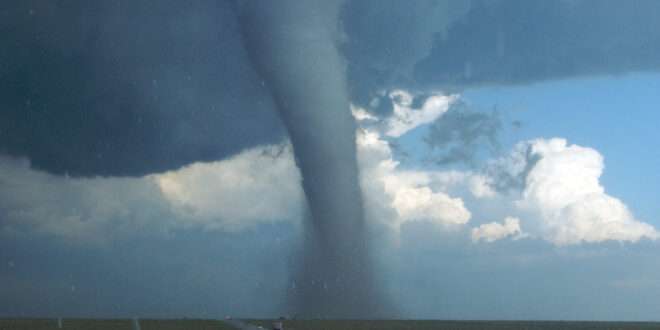It’s severe weather season. As many people in this part of the country are aware, strong thunderstorms and even tornadoes can strike quickly and fiercely. Dangerous, damaging storms can catch motorists on the roads, so AAA urges drivers and their passengers to be prepared and take appropriate safety precautions should they encounter severe weather while traveling in a vehicle.
“Storms are common throughout the spring and summer, so chances are, drivers will face storm-related challenges while in their vehicles,” said Kara Hitchens, AAA spokesperson. “A vehicle can either be very dangerous or a place of safety, depending on the weather conditions. The key is being prepared for severe weather and reacting the right way to what Mother Nature throws at you.”
Heavy Rain and Flooding
Heavy downpours make it difficult to see while driving. AAA recommends regularly changing windshield wiper blades to keep drivers’ views as clear as possible. If visibility is severely limited during heavy rain, drivers should reduce their speed and if they can safely do so, pull off the road out of traffic lanes, turn on flashing hazard lights, and wait until the rain lightens.
Drivers should be reminded that it is Ohio law that if windshield wipers are on, headlights should be as well. Headlights can help divers see better but also allow their vehicle to be seen by other drivers.
Pooling water on roadways can cause hydroplaning and loss of vehicle control, so motorists should reduce their speeds during rainy conditions. Roadways completely covered by water are a particular danger.
“Avoid driving into floodwater,” warned Hitchens. “Flooding causes more deaths than any other storm-related event, and many of those deaths occur in vehicles. As little as 12 inches of moving water can sweep most vehicles off the road. The slogan ‘Turn around, don’t drown’ is an important one to remember and follow.”
Hail
Hailstorms hit with little warning and usually only last for about five minutes, but hailstones – frozen pellets of rain – can cause major damage in that short period of time.
There were nearly 7,000 major hailstorms (hail stones one inch in diameter or larger) in the U.S. in 2023, with 459 – third most in the nation – occurring in Kansas, according to the National Oceanic and Atmospheric Administration (NOAA). Most hailstones are about the size of a pea or marble, but they can get as large as a softball in a severe storm.
“Hail of most any size can dent your car, and larger stones can smash your windows,” said Dan Scroggins, vice president of personal lines, The Insurance Agency at AAA. “And this is not an uncommon occurrence in this part of the country. Fortunately, hail damage to a vehicle is covered by your comprehensive auto insurance policy, which covers physical damage to your vehicle not caused by a collision.”
To protect your car from hail storms, park your car in a covered spot whenever possible.
If you’re in your car when a hailstorm hits and see a safe place close-by, such as a highway overpass or gas station or bank awning, drive to it as soon as you can. If no shelter is available and hail becomes large enough to cause damage, stop driving and pull off the road completely. Move away from car windows and cover your head with your arms and hands to protect yourself from any breaking glass.
Lightning
The National Weather Service reports that lightning strikes about 25 million times a year, killing about 20 people in the United States and severely injuring hundreds more.
If you are caught outside during a thunderstorm, seek shelter in a hard-topped vehicle, or a low area, such as a tunnel. If you are already in your car when a lightning storm begins, stay in the vehicle for shelter, but steer clear of fences, isolated trees, telephone poles, power lines and pipelines.
Lightning-caused damage to a vehicle is typically covered under the comprehensive portion of an auto insurance policy, said Scroggins. Thunderstorms can sometimes have other impacts to vehicles, including:
- Damage caused by falling trees due to high winds. This kind of damage is typically covered by standard auto insurance policies. However, if the tree was known to be weak before the storm, the damage may not be covered.
- A wildfire that results from a lightning storm can cause damage to cars. Insurance coverage for wildfire, even if caused by lightning, is included in the comprehensive coverage of an auto insurance policy.
Tornadoes
NOAA reports that the United States is the most tornado-prone country in the world, with about 1,000 tornadoes touching down each year. There were more than 1,400 documented tornadoes in the United States – 56 in Kansas – in 2023.
Tornado warnings mean danger is imminent. If a tornado is sighted, move to the safest place possible.
“If you are in your car and a tornado is close, abandon the vehicle and seek shelter in a storm shelter or sturdy structure,” said Hitchens. “As a last resort, if no structure is nearby, take shelter in your vehicle – seatbelt buckled; duck down below windows; cover up with a blanket to protect you from glass/debris; and protect your head with your arms.”
Also when taking cover from a tornado, stay away from trees, signs or cars/machinery and avoid seeking shelter where they could fall on or blow over onto you. Most tornadoes travel southwest to northeast, so take that into account when taking shelter.
Emergency KitAAA recommends that motorists create a spring/summer severe weather emergency kit to carry in their cars. The kit should include items such as nonperishable food/snacks and water, tool kit, flashlight, hand-crank or battery-powered radio, extra batteries, cell phone and charger, first-aid supplies, flares or reflectors, rain coat or poncho, a towel or blanket, and rain boots or an extra pair of shoes.
 WQIO Ohio's Super Station
WQIO Ohio's Super Station


